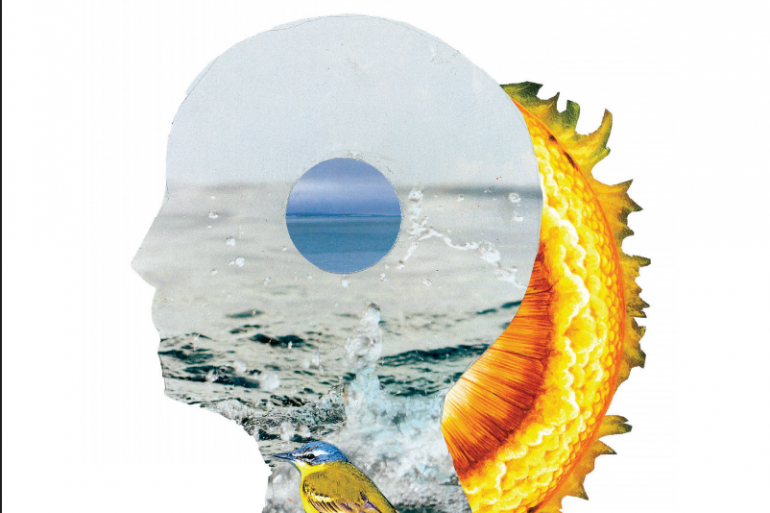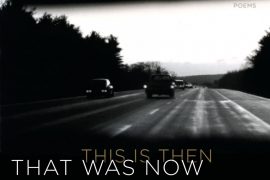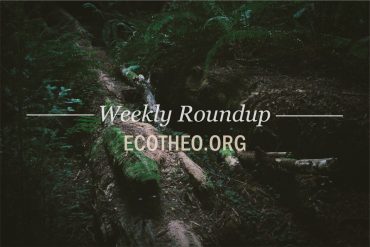A Conversation between Claire Wahmanholm and Hannah VanderHart
EcoTheo: In Webster’s introduction to The Sea Came Up and Drowned, where she contextualizes her book’s process as erasures made from John McPhee’s Pulitzer-prize winning geological text Annals of the Former World, she writes: “I realized that I was ‘mining’ poems from a book about the earth, extracting the brilliant, combustive ore of McPhee’s language for my own use. I saw the irony of this, which is the irony of the capitalist mind, which knows the earth primarily through exploitation.” What are your thoughts on “mining” a text, and Webster’s process?
Claire Wahmanholm: I’m really interested in the metaphors that Webster uses to describe her process. She does use the language of mining (fracturing, extracting, excavating, etc.) but also the language of divination (or dowsing). The first of these is obviously exploitative, but the metaphor of divining (which she calls “communication with the earth” (ii)) opens up more redemptive possibilities. But she doesn’t choose one or the other; the tension ultimately remains unresolved. This reflects, maybe, the difficulty (impossibility?) of colonizers being in right relationship to the earth, which is one of the themes in the background of the book.
AND INTERESTINGLY, McPhee also uses geologic/mining metaphors to describe his own writing. I hadn’t been familiar with Annals until I read Webster’s book (shame on me! It’s amazing!), but I checked it out from the library and was really tickled to discover lots of similarities between his project and Webster’s. For example, McPhee also includes a craft/process essay (he calls it a “narrative table of contents”) where he writes things like “I was an English-major designate, but in the decades of writing that followed […] the geology lay there to be tapped” (my emphasis) and “Like all writing, writing about geology is masochistic, mind-fracturing self-enslaved labor” (also my emphasis)). Which makes you wonder how deeply those metaphors are embedded into our artistic consciousnesses!
But I’ve been thinking a lot about erasure and whether the relationship between the source text and artist can ever get fully away from the appropriative/exploitative or what-have-you. I’d really like it to, since all of my erasure projects have been based on texts I only have admiration and respect for. But is that me being an idealist and wanting the best of both worlds? I’d love to place my work more within the realm of collaboration, but is it truly a collaboration if the author of the source text isn’t responding or contributing in real time?
I’m currently working on a series of erasures (gah, I want there to be a better word for this! Even as I write it!) of Lacy M. Johnson’s wonderful 2019 New Yorker article “How to Mourn a Glacier.” I contacted her about getting permission for the project, and she was understandably wary of the politics of erasing an article about climate change and glacial melt, etc. And I was trying to find the language to talk about my relationship to her article (as well as the final product’s relationship to her original text) and it was really hard! Just the word “erasure” has so many connotations that maybe we can’t ever get away from, especially since the word has real socio-political meanings outside of literary practice. I ended up writing her this like, 1000-word essay where I was really trying to assure her that I wasn’t trying to be gross or sneaky or hostile, and trying to explain my approach as one more akin to close reading than anything else (and since the close readings are using only the language of the original text, they seem more deferential to me than your standard piece of critical writing). And I’m sure she was like “omg you fucking weirdo fine take my permission and get out of here.”
ET: Since John McPhee travelled with a geologist named David Love, the word “Love” enters Webster’s found poetry, and takes on an allegorical role (as does “Grace”). How do you see the form of allegory working in Webster’s poetry? Do you have any strong associations with allegory?
CW: I don’t know much about allegory! But her use of Love does make me think about the role of intention in this book. Obviously any time you construct a found poem, your artistic/intentional range is limited, and you end up being guided by the text to a certain extent. But in my practice, at least, the choices you make are just as much about your own interests/preoccupations as the vocabulary that you have available to you.
I’m interested in the way that Love’s presence in Annals seems to override Webster’s control over her process. In the introductory essay she writes: “I kept opening at random to those pages, which means that questions of Love kept showing up in my poems”; “the poems I mined turned out to be, in part, about a failed relationship”; “I seemed to be writing about the transactional, use-based thinking that stops love from coming to fruition” (ii). The way Webster tells it, Love is like the magnet that pulls iron filings into a pattern around it. Which is a far less self-centered explanation than my own would be. I’m more likely to say that since love is on my mind for x y or z reason, I’m more likely to gravitate toward incorporating it when it appears.
But it makes me think about the pull of erasures, and why we might undertake them instead of non-erasures. In her craft essay, Webster mentions that this project started from a place of anxiety and isolation, and in reaching for a text that would speak back to her: “One night while I was wide awake worrying, I decided to ‘divine’ a message for myself,” she writes. “I had a book that I’d picked up somewhere called Divination, and I pulled it from my shelf.” But the text she reached for is not the text she got: “Divination was stuck to Annals of the Former World, and when I grabbed Divination, The Former World fell open on my desk, heavy as a geode” (i). And although this text came to her accidentally, she found that, serendipitously, its fragments “seemed to perfectly name [her] emotional state” (i). And she also returned to the project years later, when she was again “lost and seeking messages” (iii). McPhee’s text became something that will lead her to proverbial water, to “a way forward” (iii).
So one thought is that we reach for erasure/close reading/midrash when the self is not sufficient—when we yearn to tap into something far larger than ourselves (but which, gratifyingly, still holds our selves, our lives, our emotions inside of it?). An experience of the divine or sacred, in other words.
ET: I think of powerful erasure texts by contemporary poets–Tracy K. Smith’s “Declaration,” Nicole Sealey’s “The Ferguson Report: An Erasure.” Erasure can be used to do violence/wield power against an oppressive text, but it can also be a form of homage (example: S. Jane Sloat’s Hotel Almighty, which is an erasure of Stephen King’s novel Misery). What do you see as the virtues of erasure poetry? What are the limits, if any?
CW: My favorite thing about erasures is that they’re a really elegant way to have an intimate conversation (confrontational or otherwise) with a source text. The erasure projects that I’m most interested in are ones that are argument-driven (in that they’re arguing for a certain subtext/interpretation of a source). Sometimes the argument is apparent within the boundaries of the erasure itself, and sometimes it comes through more clearly within the context of a larger work (for example, if the erasures are intercut with other non-erasures within a book). You could always present that argument in the form of a critical essay, but there are obvious advantages to being able to do it in poem form.
The other thing I really like about erasure is that it invites me to think about metaphor (this goes back to our earlier exchange about Webster’s metaphors of extracting vs. divining/dowsing). Like, if I look at Webster’s poems as ore deposits, and the source text as the Earth, what does that do for the project? But if I look at the poems as ground water brought to the surface, the project is totally transformed. Because of my background, the metaphor that most often guides my own approach is parent/child (though I acknowledge this a biologically-circumscribed model, and thus limited). Like, the poem would not exist without the source text, obviously, but the source text (or at least the way we view it) has also been altered by the poem that’s been pulled from it. The relationship can be wide-ranging in tone, and the source material can produce practically infinite combinations of poems depending on the circumstances.
But erasures are also a pretty risky form in some ways. Because the mechanics of erasures seem relatively simple, it’s also relatively easy to produce weak ones (where, for example, an erasure will just replicate the source text but in a more compressed way). Or the erasure might be really compelling on a conceptual level, but not terribly interesting on the level of language (and vice versa). Though of course that’s a risk that’s shared with non-erasure poetry, too. There’s also the risk that an erasure project might need too much explanation in order to be best understood, though I think readers probably feel a range of feelings about this—some are probably happy to have the goals of the project set out for them; some would rather be able to jump in unaided.
ET: Webster’s text has some stunning visuals, and in her introduction Webster notes: “I made these collages at my kitchen table, with cut up printouts of open source photography and cheap children’s Crayola watercolors, while my daughter painted and played beside me. Often, I would set out to make something beautiful, but the collage would envision wildfires, earthquakes or flooding.” How do Webster’s visuals affect your reading? And more broadly, what do you think of visual components in poetry collections?
CW: Though she says the collages envision natural disasters, that wasn’t my primary take-away from them (at least the ones that she included in the book—there are more in this series, I think, which you can find on her website). I can see flooding in “In a Field of Destructive Torrents,” and I see the remnants of a wildfire in “Drowning,” but my main impression from the collages was actually one of connection and reparation. And though Webster acknowledges that the cut-ups were a “way for [her] to grapple with the continual stress and fracturing of our planet,” she also hopes that they “offer little glimpses of connection and vision” (v).
Sometimes I felt like the erasures were inhabiting the grimmer of the collection’s impulses, while the cut-ups inhabited the more hopeful. But in several places, the cut-ups and the erasures seem to be doing similar work. In the poem “Salt,” the speaking “we” realizes that “two differing halves had been / placed together” (35), which is what we see in collages like “Drowning,” “Desertification,” and “Crowded Earth.” And it’s easy to read the “two differing halves” as the human and the non-human, which the collages also yoke together—“Countdown to Irreversibility” features a woman superimposed over a tree that stretches into the night sky; “We are a Species” features two human silhouettes filled with starlight and misty horizon rather than shadow; “What We Build” features a pair of butterflies flitting near a pair of human hands.
Neither the erasures nor the collages offer a whole picture—something is either missing (in the first case) or impinging on the panorama (in the second). But the effect of this incompleteness is different. When I encounter the erasures, my eyes leap across the whitespace in a rhythmically stuttering sort of way. But when I look at the collages, my eyes do this dance of disentanglement, where they try to find the edges of each visual element (which overlap and intermingle like floaters). Both modes require fairly active reading/interpretation.
I’m a big fan of visual poetry! Obviously Tom Phillips’s A Humument comes to mind, but I also love Matthea Harvey and Amy Jean Porter’s Of Lamb, Katy Didden’s Lava erasures (“[like an animal]” also uses a John McPhee text as its source, coincidentally!), and Sarah J. Sloat’s Hotel Almighty, which you mention above. In all these projects, the erasures are embellished with visual art, rather than existing separately from it. I think separating them is certainly a risk, in that it invites readers to compare the two modes (do I like the erasures better? Or do I like the collages better? Which are more skillful? etc.) rather than seeing them in concert.
ET: Claire, you are the author of the poetry collections Wilder (Milkweed Editions, 2018) and Redmouth (Tinderbox Editions, 2019), and the forthcoming Meltwater (Milkweed Editions, 2023). As someone whose work engages ecological crisis and climate disaster, you bring a particular thematic kinship to reading Webster’s work. What are some ways Webster’s attention offers openings into conversations we are having now about climate change?
CW: I’m glad Webster directs our attention toward Indigenous-led environmental and social-justice movements; without the leadership and expertise of Native nations, there can be no meaningful departure from our capitalist-fueled descent into climate chaos, land exploitation, and displacement. She speaks about this in greater depth here!





